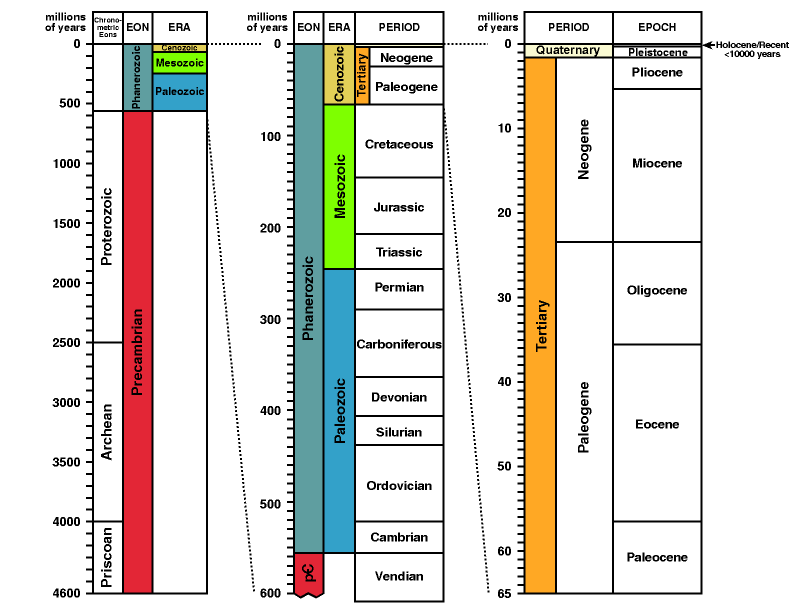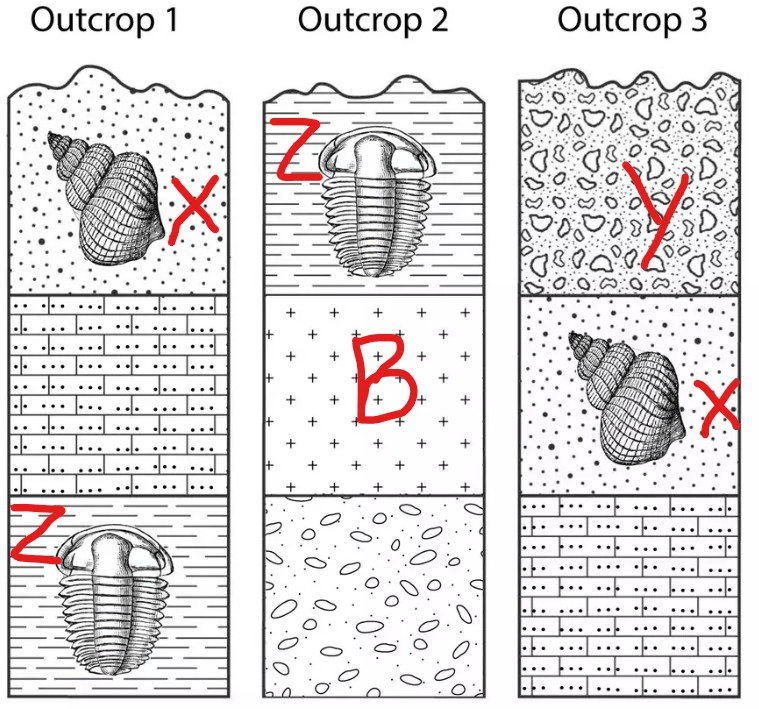Name the five principles of relative age dating.
- superposition
- original horizontality
- lateral continuity
- inclusions
- cross-cutting concepts
Define an unconformity.
Breaks or gaps in the rock record.
The matching of exposed rock layers between rock beds in two different regions.
Draw and annotate a model representing superposition.

Identify the different time scales present in the geologic time scale in order from largest to smallest.
- eon
- era
- period
- epoch
The rock record contains a complete history of Earth's past. True or False? Why?
False. Unconformities can cause a breakdown of rocks and fossils or weather-related events were too drastic and prevented the formation of fossils and rock beds.
What are the three types of unconformities? Define them
- angular unconformity: the tilting or uplifting of rock layers
- disconformity: sedimentary rock overlying another sedimentary rock creating smooth surfaces where they interact
- nonconformity: sedimentary rock overlying eroded igneous rock
True or false? Scientists can use any fossil to create correlations between rock beds. Explain.
False. Scientists can only use index fossils to create correlations because index fossils represent organisms that were:
- abundant (there are a lot of fossils)
- widespread (inhabited many locations)
- short-lived (seen in very few rock layers)
Create and annotate a model portraying an unconformity.

Agree or disagree. All eras represent the same amount of time. Explain.
Disagree because units of time on the geologic time scale are dependent on major geologic events which do not occur at specific intervals, in other words, they are random events.
Specific rock beds that are distinct from all other rock beds and serve as geologic markers are called ___.
key beds
Identify the following unconformities (only 1 of each): angular unconformity, disconformity, nonconformity

- angular unconformity
- nonconformity
- disconformity
Finish the prompt. Key beds are useful because ___.
Key beds are useful because they contain distinct (unique) features that make them easily identifiable in different rock beds of different regions.
Create and annotate a model portraying a correlation.
The lines represent a correlation.

According to the model, periods are comprised of eons. Evaluate and explain.
The claim is incorrect. On the geologic time scale, the dashed lines represent a zoom-in of the eons into eras and eras into periods. As a result, eons are comprised of eras and periods.
A student affirms the following:
"Rock layer B is younger than rock layer Y."
Evaluate the affirmation.
The student is incorrect. Using the law of superposition, the student could determine the following:
1) rock layer B is older than rock layer Z because it is lower in the rock record.
2) Additionally, rock layer X is younger than rock layer Z because it is higher in the rock record than Z.
3) Lastly, rock layer Y is younger than rock layer X because it is above rock layer X.
Synthesizing the information, rock layer Y must be younger than rock layer B so the student is incorrect.
Describe the relationship between the rock layers and the geologic time scale.

The geologic time scale is a representation of changes to the composition of the rock layers and fossils. Major geologic events or changes typically form unconformities which can mark the end of one period of time and the start of another.